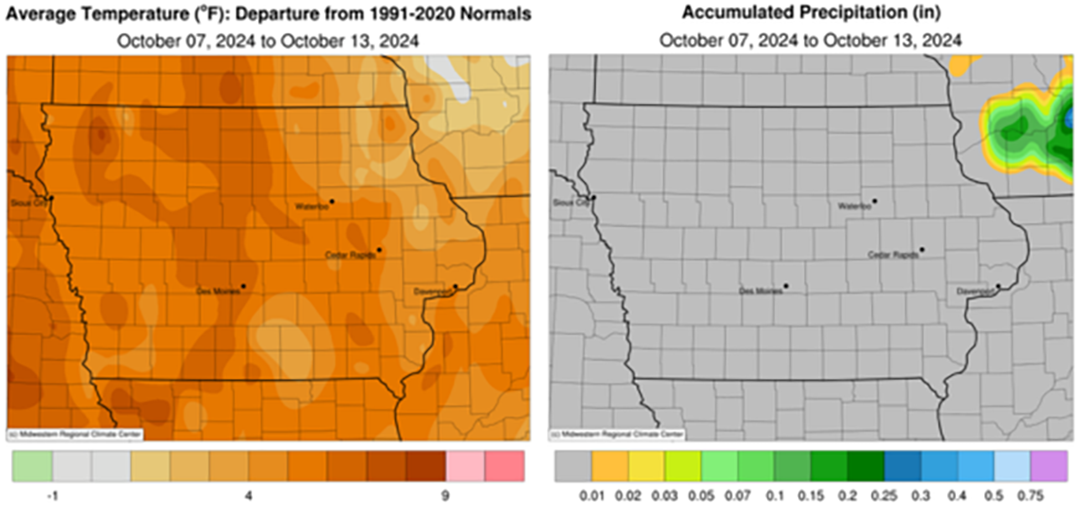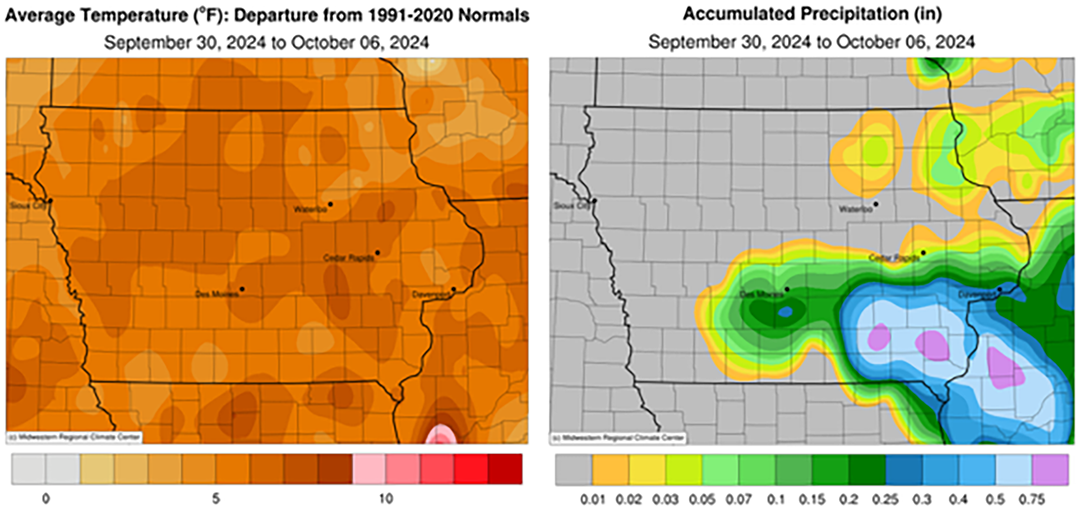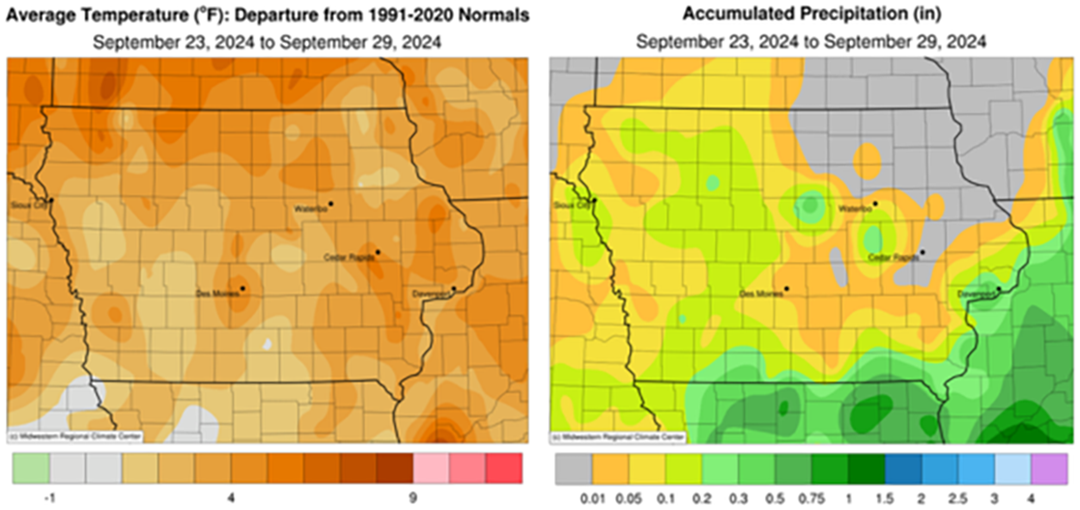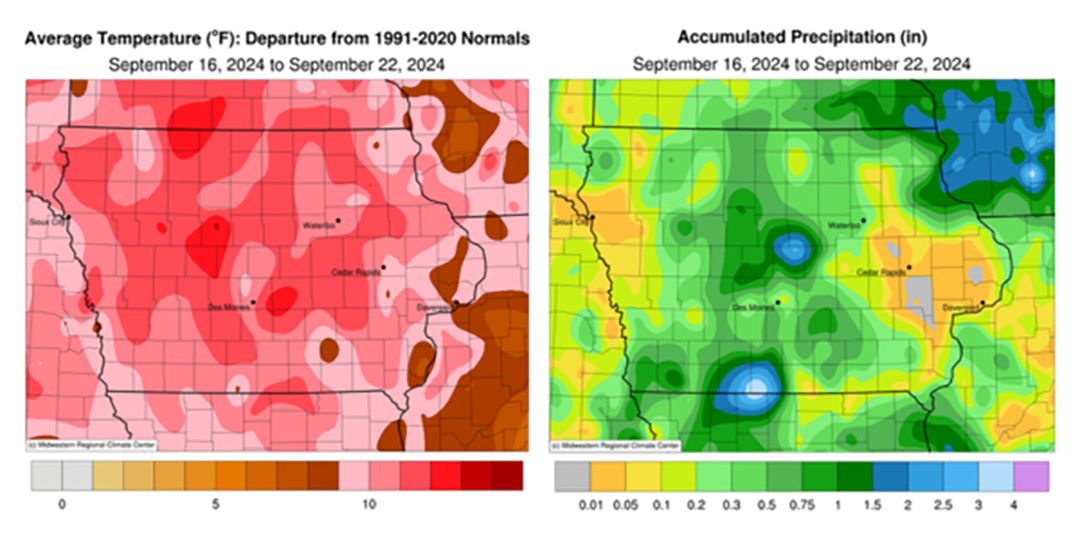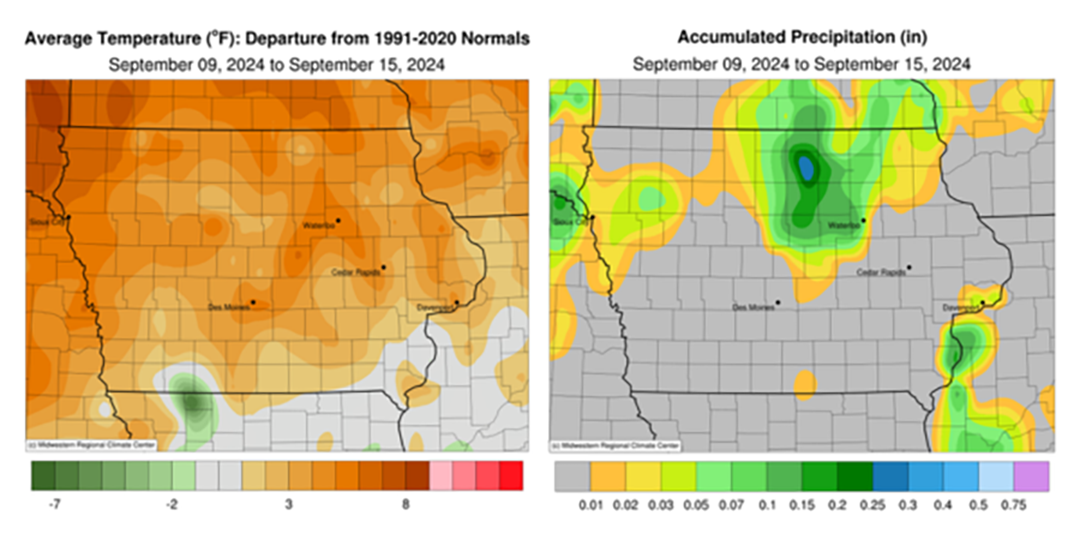Weekly Crop Progress and Condition Report — Oct. 22, 2024
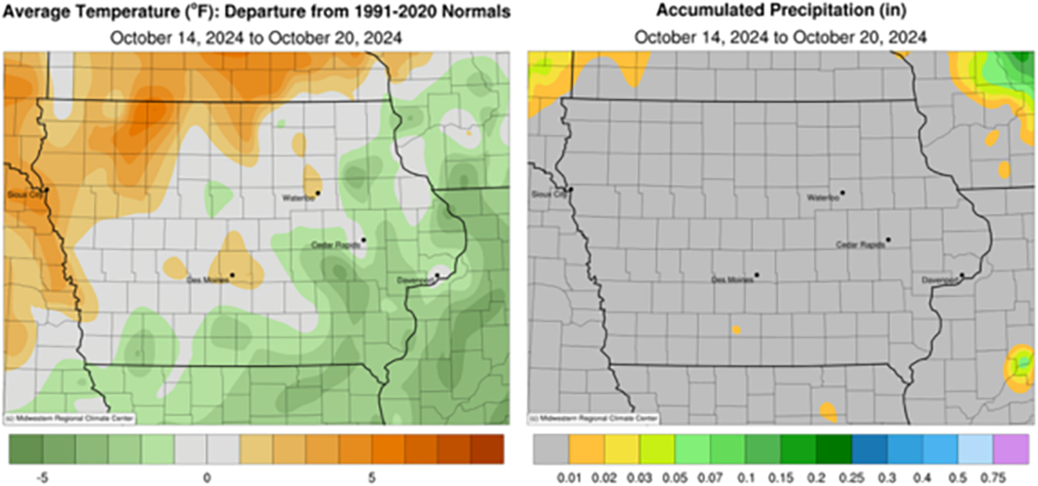
Released by the USDA National Agricultural Statistics Service
Iowa Secretary of Agriculture Mike Naig commented on the Iowa Crop Progress and Condition Report released by the USDA National Agricultural Statistics Service. The report is released weekly April through November. Additionally, the Iowa Department of Agriculture and Land Stewardship provides a weather summary each week during this time.
“After another dry week, Iowa’s harvest took another sizable step toward the finish line,” Secretary Naig said. “Heading into the last stretch of October, temperatures are expected to remain warmer than average with more chances of precipitation, which could slow or temporarily pause harvest in areas. With drought conditions continuing to spread, we would welcome a shot of rain to reduce fire risks, get cover crops established and begin to replenish our soils, streams and pastures.”
The weekly report is also available on the USDA’s website at nass.usda.gov.
Crop Report
Row crop harvest remained ahead of average as Iowa’s farmers had 6.8 days suitable for fieldwork during the week ending October 20, 2024, according to the USDA, National Agricultural Statistics Service. Field activities included harvesting corn and soybeans, fall tillage, and applying manure and fertilizer. Dry conditions resulted in field and equipment fires being reported during harvest.
Topsoil moisture condition rated 41 percent very short, 40 percent short, 19 percent adequate and 0 percent surplus. Subsoil moisture condition rated 31 percent very short, 46 percent short, 23 percent adequate and 0 percent surplus. For the second straight week, most of the State received no measurable precipitation.
Nearly all of Iowa’s corn crop reached the mature stage or beyond. Harvest of the corn for grain crop reached 68 percent complete, 5 days ahead of last year and 10 days ahead of the five-year average. Farmers in south central Iowa remained behind farmers in the rest of the State with just 50 percent of their crop harvested. Moisture content of field corn being harvested was 15 percent. Soybeans harvested reached 91 percent, 1 week ahead of last year and almost 2 weeks ahead of the average. Farmers in northern Iowa, as well as west central and east central, have already harvested 94 percent or more of their soybeans.
Pasture condition fell another 8 percentage points to 22 percent good to excellent this week. Ponds and creeks in pastures are drying up as pastures go dormant due to the dry conditions. Some cattle are being turned onto corn stalk fields.
Weather Summary
Provided by Justin Glisan, Ph.D., State Climatologist, Iowa Department of Agriculture and Land Stewardship
The second driest October in 152 years of records continues as only a handful of Iowa stations reported meager rainfall totals. Much of the state also experienced the first widespread freeze early in the reporting period. Overall, temperatures varied from below normal southeast to above normal northwest; the statewide average temperature was 49.9 degrees, 0.8 degree below normal.
Gusty northwesterly winds persisted through Sunday (13th) afternoon with highs in the upper 50s and low 60s. Mostly cloudy skies in eastern Iowa gave way to clear conditions into Monday (14th). Morning lows dropped into the 20s in western Iowa with upper 30s to low 40s farther east. Partly cloudy conditions developed across central Iowa through the day as temperatures held in the 50s. Cloud cover increased across much of Iowa overnight with isolated light showers forming in southern Iowa; trace amounts of rainfall were reported at eight stations, including Des Moines International Airport (Polk County) while four stations collected 0.01 to 0.02 inch in Clarke and Henry counties. A strong high pressure system dominated the Upper Midwest through Tuesday (15th) with ample sunshine and daytime highs returning to the mid to upper 50s. The coldest temperatures of the season were reported on Wednesday (16th) morning with upper teens to low 30s observed west to east across the state; the statewide average low was 26 degrees, 13 degrees below normal. With a southerly shifting wind, afternoon temperatures warmed into the low 60s with clear skies persisting. Overnight lows varied from the mid 30s southeast to upper 40s northwest under starry skies. Strong southerly winds continued through the day on Thursday (17th), pushing temperatures into the upper 60s and low 70s statewide. Morning temperatures, in the low to mid 50s, were 10-15 degrees above normal in western Iowa with more seasonal temperatures across much of the rest of the state. Friday (18th) was pleasant with low 70s, blustery southerly winds and clear skies. Saturday (19th) dawned with partly to mostly cloudy skies in western Iowa with clear skies over eastern Iowa. Low temperatures under clouds were in the 50s while mid 30s to low 40s were reported east. Afternoon temperatures hit the low to mid 70s with some spotty clouds remaining in western Iowa. Wind speeds decreased into Sunday (20th) with lows in the 50s under clear skies.
Weekly precipitation totals ranged from no accumulation across the vast majority of Iowa to 0.02 inch in Osceola (Clarke County). There was no measurable weekly statewide average precipitation; the normal is 0.55 inch. Waterloo Municipal Airport (Black Hawk County) reported the week’s high temperature of 85 degrees on the 20th, 24 degrees above normal. Mapleton (Monona County) reported the week’s low temperature of 17 degrees on the 16th, 20 degrees below normal.

